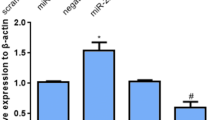Abstract
Hypertrophic scars result from a dysregulated process in wound healing. Although the basic mechanism is unclear, increased proliferation and decreased cell apoptosis are noticed in the development of hypertrophic scar. In previous study, we found that secreted frizzled-related protein 2 (SFRP2), which was associated with cell proliferation, apoptosis, and differentiation, was dramatically upregulated in hypertrophic scar (HS) tissue. In this study short hairpin RNA (shRNA) targeting SFRP2 was employed to characterize SFRP2 function in hypertrophic scar-derived fibroblasts (HSFb). Cell proliferation was assessed by MTT, dynamic growth curves, and BRDU assays. Meanwhile, Cell apoptosis was detected using fluorescence-activated cell sorting (FACS). Caspase-3 activity was assayed by spectrophotometry. Fibroblast populated collagen lattice (FPCL) model was employed to evaluate the contractility of HSFb. Further, real-time PCR and western blot were used to measure the mRNA and protein expressions of α-SMA in HSFb. In addition, mRNA levels of type I and III procollagen were assayed by quantitative real-time PCR. The results revealed that shRNA targeting SFRP2 significantly promoted the apoptosis of HSFb, while it had no effect on the cell proliferation. Decreased synthesis of a-smooth muscle actin (α-SMA) in HSFb and reduced contraction of fibroblasts in the FPCL model were observed. Quantitative RT-PCR suggested that the mRNAs of type I and III procollagen were significantly downregulated. In conclusion, as a novel anti-apoptosis gene, SPRP2 was present in hypertrophic scars. Importantly, shRNA targeting SFRP2 may provide a new approach to preventing the formation of HS.




Similar content being viewed by others
References
Clark JA, Cheng JC, Leung KS (1996) Mechanical properties of normal skin and hypertrophic scars. Burns 22:443–446
Al-Attar A, Mess S, Thomassen JM et al (2006) Keloid pathogenesis and treatment. Plast Reconstr Surg 117:286–300
Hou XH, Cao B, Liu HQ et al (2009) Effects of osthole on apoptosis and TGF-beta1 of hypertrophic scar fibroblasts. J Asian Nat Prod Res 11:663–669
Cao B, Jiang MC, Lei ZY et al (2008) Effects of PLAB on apoptosis and Smad signal pathway of hypertrophic scar fibroblasts. J Asian Nat Prod Res 10:147–157
Tomasek JJ, Gabbiani G, Hinz B et al (2002) Myofibroblasts and mechano-regulation of connective tissue remodelling. Nat Rev Mol Cell Biol 3:349–363
Desmoulière A, Redard M, Darby I et al (1995) Apoptosis mediates the decrease in cellularity during the transition between granulation tissue and scar. Am J Pathol 146:56–66
Su CW, Alizadeh K, Boddie A et al (1998) The problem scar. Clin Plast Surg 25:451–465
Teofoli P, Barduagni S, Ribuffo M et al (1999) Expression of Bcl-2, p53, c-jun and c-fos protooncogenes in keloids and hypertrophic scars. J Dermatol Sci 22:31–37
Wassermann RJ, Polo M, Smith P et al (1998) Differential production of apoptosis-modulating proteins in patients with hypertrophic burn scar. J Surg Res 75:74–80
Li F, Fan C, Cheng T et al (2009) Efficient inhibition of fibroblast proliferation and collagen expression by ERK2 siRNAs. Biochem Biophys Res Commun 382:259–263
De Felice B, Garbi C, Santoriello M et al (2009) Differential apoptosis markers in human keloids and hypertrophic scars fibroblasts. Mol Cell Biochem 327:191–201
Chen W, Fu X, Sun X et al (2003) Analysis of differentially expressed genes in keloids and normal skin with cDNA microarray. J Surg Res 113:208–216
Chang JT, Esumi N, Moore K et al (1999) Cloning and characterization of a secreted frizzled-related protein that is expressed by the retinal pigment epithelium. Hum Mol Genet 8:575–583
Kobayashi K, Luo M, Zhang Y et al (2009) Secreted frizzled-related protein 2 is a procollagen C proteinase enhancer with a role in fibrosis associated with myocardial infarction. Nat Cell Biol 11:46–55
Jones SE, Jomary C, Grist J et al (2000) Altered expression of secreted frizzled-related protein-2 in retinitis pigmentosa retinas. Invest Ophthalmol Vis Sci 41:1297–1301
Alfaro MP, Pagni M, Vincent A et al (2008) The Wnt modulator sFRP2 enhances mesenchymal stem cell engraftment, granulation tissue formation and myocardial repair. Proc Natl Acad Sci 105:18366–18371
Aarabi S, Bhatt KA, Shi Y et al (2007) Mechanical load initiates hypertrophic scar formation through decreased cellular apoptosis. Faseb J 21:3250–3261
Satoh W, Matsuyama M, Takemura H et al (2008) Sfrp1, Sfrp2, and Sfrp5 regulate the Wnt/beta-catenin and the planar cell polarity pathways during early trunk formation in mouse. Genes 46:92–103
Rai NK, Tripathi K, Sharma D et al (2005) Apoptosis: a basic physiologic process in wound healing. Int J Low Extrem Wounds 4:138–144
Bergler W, Petroianu G, Schadel A (1993) Feasibility of proliferation studies using the BrdU and MTT assays with a head and neck carcinoma cell line. ORL J Otorhinolaryngol Relat Spec 55:230–235
Linge C, Richardson J, Vigor C et al (2005) Hypertrophic scar cells fail to undergo a form of apoptosis specific to contractile collagen-the role of tissue transglutaminase. J Invest Dermatol 125:72–82
Sathi GA, Inoue M, Harada H et al (2009) Secreted frizzled related protein (sFRP)-2 inhibits bone formation and promotes cell proliferation in ameloblastoma. Oral Oncol 45:856–860
Desmouliere A, Geinoz A, Gabbiani F et al (1993) Transforming growth factor-beta 1 induces alpha-smooth muscle actin expression in granulation tissue myofibroblasts and in quiescent and growing cultured fibroblasts. J Cell Biol 122:103–111
Oliveira GV, Hawkins HK, Chinkes D et al (2009) Hypertrophic versus non hypertrophic scars compared by immunohistochemistry and laser confocal microscopy: type I and III collagens. Int Wound J 6:445–452
Nedelec B, Shankowsky H, Scott PG et al (2001) Myofibroblasts and apoptosis in human hypertrophic scars: the effect of interferon-alpha2b. Surgery 130:798–808
Acknowledgments
The study was supported by the National Natural Science Foundation of China (Project Number: 30872695) and the Science & Technology Department of Sichuan Province (Project Number: 2008JY0082)
Author information
Authors and Affiliations
Corresponding author
Rights and permissions
About this article
Cite this article
Sun, Z., Li, S., Cao, C. et al. shRNA targeting SFRP2 promotes the apoptosis of hypertrophic scar fibroblast. Mol Cell Biochem 352, 25–33 (2011). https://doi.org/10.1007/s11010-011-0736-2
Received:
Accepted:
Published:
Issue Date:
DOI: https://doi.org/10.1007/s11010-011-0736-2




